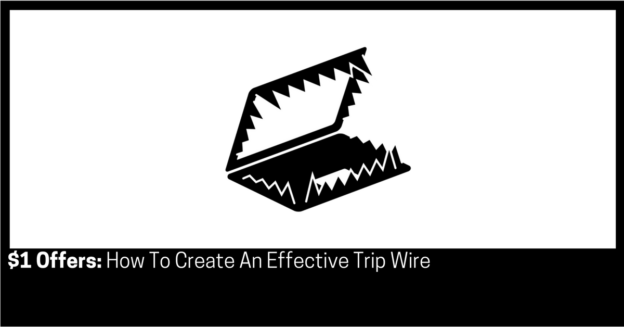Every time I drive past Hungry Jacks I see similar ads and offers to the following:
- $1 Small Coffee; or
- $1 Medium Thick Cut Chips;
- And so on…
At first sight, you may wonder why Hungry Jacks offer this?
$1 Coffee?!
$1 Fires?!
How on earth could they make any profit off these?!
They don’t.
And Hungry Jacks knows this and that’s the point.
But you may be asking why would Hungry Jacks not want to make profit…
…Isn’t that the purpose of being in business?
Yes it is, but it’s the ultimate purpose.
Not the purpose of these offers.
Or any offer at the start of a pipeline.
The purpose of these offers is to convert a prospects (a prospect is someone who hasn’t purchased yet) into customers (someone who has purchased already.)
This offer is called a Tripwire Offer.
Or a Low Priced Offer.
A Tripwire is a wire stretched close to the ground that work as a trap, explosion, or alarm when it is disturbed and is aimed at detecting or preventing people or animals entering an area.
Used in a marketing and sales context, it is an offer (like the examples) that work as a trigger when purchased, to detect when a person moves from a prospect to a customer.
This is about sales and converting leads to paying customers.
At this point, prospects have now become customers.
This is a very powerful buying psychological decision.
If you recall back to the “few ways to market and sell” I mentioned at the start of the guide, this means they are more likely to buy higher-priced offers (such as Main Offers and Profit Offers), more often.
This is also called a Loss Leader.
A Loss Leader is defined as a product sold at a loss to attract customers.
Smart marketers will also price their low priced offer at the same price it costs them to acquire traffic in the first place.
I refer this strategy as a “Self-Paying Offer.”
For example, if it costs you $10 to acquire traffic and convert that traffic to customers via a low priced offer, then you should aim to price your low priced offer at $10 as well, to make it cost neutral.
This means you can buy as many customers as you can find dollars to pay for them, without being at a loss.
The Low Priced Offer then becomes a Loss Leader, and you build up a list of customers for free, even if you have made no profit at this stage.
This is much more beneficial than just having a list of prospects.
The Tripwire acts both as an incentive to come into the shop, but also to buy.
Hungry Jacks could have just used a Gated or free offer which would have just got a prospect to come in and redeem it and be less likely to buy and up sell.
So Hungry Jacks uses a Tripwire to do both things in one offer.
Hungry Jacks actually makes all their profit on the drinks and the upselling of drinks.
When you think about it, what is Coke made up of?
- Sugar;
- Water;
- Flavouring; and
- A shit-load of profit!
The first three all being very cheap to produce.
So here are some other examples of Tripwires:
So you may be asking, “how do you create an effective Tripwire?”
It’s simple…
You take your full featured product in your Main Offer.
In Hungry Jacks’ case a Large Meal of burger, drink and fries.
Then you take one of those item, which is ideally:
- Low cost;
- Low profit margin/mark-up;
- Scaleable delivery; and
- High perceived value.
And offer it for a nominal, yet really attractive price, like $1.
For example you’d offer the burger or fries for $1, as they did in the example before.
The price need to be relative, as you probably wouldn’t offer a $10,000 Main Offer’s tripwire for a $1, but you may.
It’s all contextual and specific examples are beyond the scope of this guide.
Incidentally, this is a very similar process of how you create an effective Free Offer too.

